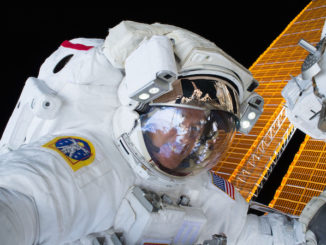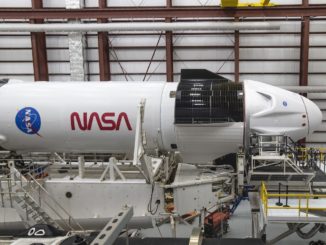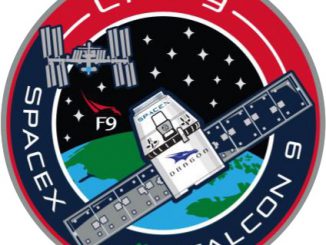
A twin-engine Northrop Grumman Antares rocket climbed into orbit Saturday from Virginia’s Eastern Shore carrying a Cygnus supply ship bound for the International Space Station with a compact electron microscope, a flame combustion experiment, a range of biological investigations, fresh cheese, fruit and vegetables for the research lab’s three-person crew.
The 139-foot-tall (42.5-meter) Antares launcher lifted off from pad 0A at the Mid-Atlantic Regional Spaceport at 3:21:04 p.m. EST (2021:04 GMT) Saturday after Northrop Grumman scrubbed two previous launch attempts due to an issue with ground support equipment and unfavorable winds aloft.
Powered by two Russian-built RD-181 engines producing more than 860,000 pounds of thrust, the Antares rocket cleared lightning protection towers at the launch pad and headed southeast from the spaceport at NASA’s Wallops Flight Facility in Virginia.
Arcing over the Atlantic Ocean, the rocket surpassed the speed of sound and shut down its liquid-fueled main engines nearly three-and-a-half minutes after liftoff. After jettisoning its first stage, payload fairing and an interstage connecting adapter, the Antares second stage Castor 30XL solid-fueled motor ignited to inject the 16,928-pound (7,678-kilogram) Cygnus spacecraft into orbit.
The Cygnus spacecraft deployed from the Castor 30XL rocket motor roughly nine minutes into the mission to conclude successfully conclude the Antares rocket’s role in the flight.
Two fan-shaped solar panels were expected to unfurl on each side of the Cygnus supply ship a few hours after launch to begin charging the spacecraft’s batteries.
A series of thruster firings were planned to begin later Saturday to steer the Cygnus spacecraft into a more than 250-mile-high (400-kilometer) orbit matching the International Space Station.
NASA astronaut Drew Morgan will operate the station’s Canadian-built robotic arm to capture the Cygnus cargo freighter around 4:05 a.m. EST (0905 GMT) Tuesday following the supply ship’s automated laser-guided approach to the complex.
The robotic arm will berth the Cygnus spacecraft to the station’s Unity module a few hours later, and the station crew will open hatches and begin unpacking some 7,445 pounds (3,377 kilograms) of cargo inside the ship’s Italian-built pressurized compartment.
Saturday’s launch marked the start of Northrop Grumman’s 13th resupply mission to to the space station under two multibillion-dollar contracts with NASA. The mission, designated NG-13, was moved forward from April to February at the request of NASA, officials said.

The Cygnus spacecraft launched Saturday aboard the Antares rocket is named the S.S. Robert H. Lawrence in honor of Air Force Maj. Robert H. Lawrence, Jr.
Lawrence was the first African American to be selected as an astronaut in the U.S. space program.
The U.S. military selected Lawrence for the Manned Orbiting Laboratory program, which intended to develop and fly space stations in Earth orbit accommodating two astronauts for month-long missions to gather surveillance imagery of the Soviet Union and other strategic locations around the world.
The Air Force announced Lawrence’s selection for the MOL program in June 1967, but he died in an aircraft training accident in December of the same year. The MOL program was canceled in 1969, and the military astronauts selected for the program under 35 years old were transferred to NASA.
“Since Lawrence was in that age range, it is virtually certain he also would have transferred,” NASA officials wrote in a feature story on Lawrence in 2018. “All in that group flew on the space shuttle in the 1980s; it is easy to imagine that Lawrence would have piloted one of the early space shuttle missions.”
Northrop Grumman names each of its Cygnus resupply vessels after a late astronaut or other space industry official.
“In 1967, the U.S. Air Force selected Maj. Lawrence as an astronaut for the Manned Orbiting Laboratory program,” said Frank DeMauro, vice president and general manager of Northrop Grumman’s tactical space systems division. “Although his career was cut short in a tragic accident, he paved the way for future aerospace pioneers of all races and enabled increased diversity and inclusion across the industry. While Maj. Lawrence never flew into space, we are proud that Cygnus will carry his name on this mission.”
The S.S. Robert Lawrence is packed with 7,445 pounds (3,377 kilograms) of supplies and experiments heading to the International Space Station. Here’s a breakdown of the cargo manifest provided by NASA:
- 3,501 pounds (1,588 kilograms) of vehicle hardware
- 2,129 pounds (966 kilograms) of scientific investigations
- 1,570 pounds (712 kilograms) of crew supplies
- 179 pounds (81 kilograms) of spacewalk equipment
- 66 pounds (30 kilograms) of computer resources

The equipment launched aboard the Cygnus supply ship includes a scanning electron microscope built by Voxa, a Seattle-area company that aims to miniaturize and reduce the cost of nano-imaging technology.
“It’s the first portable scanning electron microscope in the world, and tomorrow it’ll also be the first portable microscope in space,” said Christopher Own, facility manger and CEO of Voxa.
Electron microscopes work by scanning electron beams over a target to create an image, telling scientists about the material’s physical characteristics and composition. A conventional scanning electron microscope can cost $1 million, and Own says his company’s unit costs around $65,000, and the price could come down if it is mass-produced.
NASA wants to test the Mochii microscope, named for the Japanese dessert, in orbit to see if the device could help scientists analyze biological samples, perform materials science experiments, and take detailed pictures of contaminants and particles that could affect the performance of equipment aboard the space station.
It sometimes takes months to get a sample back to Earth for analysis in ground-based labs. SpaceX’s Dragon capsule is the only vehicle capable of returning large amounts of cargo to the ground intact.
A microscope like the Mochii device on the space station could allow scientists to analyze samples soon after they are gathered. What’s more, the microscope can be operated remotely by researchers on the ground.
“When we came up with the concept, we thought what about the dessert mochii,” Own said. “It’s small, cute and absolutely delicious. Everybody will want one.”
Astronauts will install the microscope inside the Japanese Kibo laboratory module on the space station, and the device will go through testing to see if it meets specifications.
“The expectation, provided that the experiments are successful up there, is to leave it up there and give it to the wider community to use,” Own said.
A range of biological research experiments also launched Saturday.
“We have an investigation going up to study cardiomyocytes, or heart cells, and see if we can more effectively grow those in space,” said Heidi Parris, assistant program scientist for NASA’s space station program office. “An investigation is looking at a certain kind of virus called a bacteriophage that is able to target specific bacteria, harmful bacteria in our bodies, while leaving the rest of our human cells intact, and the good bacteria and our microbiome intact.
“We have an investigation that’s looking at the molecular mechanisms behind bone formation and bone loss,” she said. “Bone loss is a huge issue for astronauts, and also for osteoporosis patients on Earth, so it’s a benefit if we understand that in the space environment and also on the ground.”
The Cygnus spacecraft also carries fresh fruit and vegetables, plus a shipment of conditioned hard cheddar and Manchego cheese, according to Ven Feng, manager of NASA’s space station transportation integration office.
“For the first time ever, we’re sending up some conditioned cheese in a little bit of extra space we had left over,” Feng said before the launch.
Small satellites hitching ride to space on Cygnus
Three small satellites are hitching a ride to the International Space Station aboard the Cygnus supply ship.
Two of the miniature spacecraft are sponsored by the Defense Advanced Research Projects Agency, or DARPA. Another was developed at NASA’s Ames Research Center in California.
The Red-Eye 2 microsatellite is the second in a series of Red-Eye satellites developed by DARPA. The Red-Eye satellites aim “to develop and demonstrate technologies that increase the utility of low-cost microsatellites,” according to NASA.
The first Red-Eye satellite launched to the station aboard a SpaceX Dragon cargo ship last year, then was released from the NanoRacks Kaber deployer in June 2019.
“Red-Eye will demonstrate lightweight, low-power, gimballed inter-satellite communications links appropriate for the class of satellites approximately 100 kg (220 pounds) in size,” NASA wrote in a summary of the experiment. “Red-Eye will also demonstrate new attitude control components, onboard processors, and software-defined radios.”
Two CubeSat-class satellites are also aboard the Cygnus supply ship for release from the space station’s smaller satellite deployer.
The Deformable Mirror, or DeMi, spacecraft is about the size of a small suitcase. Developed at the Massachusetts Institute of Technology, the deformable mirror instrument will demonstrate technologies that could be used on future space telescopes making high-contrast observations of exoplanets around bright stars. Such precision observations, which will use coronagraphs to blot out the light of the star, require the use of deformable mirrors inside the telescope that can be adjusted using internal actuators, according to MIT.
The deformable mirrors “can correct image plane aberrations and speckles caused by imperfections, thermal distortions, and diffraction in the telescope and optics that would otherwise corrupt the wavefront and allow leaking starlight to contaminate coronagraphic images,” MIT scientists wrote in a summary of the demonstration.
DARPA is funding the DeMi experiment, and Aurora Flight Sciences is managing the mission.
NASA’s TechEdSat 10 nanosatellite is the next in a line of experimental CubeSats developed at the Ames Research Center in California. According to NASA, the TechEdSat 10 spacecraft will function as a high temperature, accurate deorbit reentry nanosatellite.
The Cygnus spacecraft will remain attached to the space station until around May 11, when it will depart to begin the second phase of its mission.
A NASA flame combustion experiment housed inside the Cygnus pressurized module will examine how flames propagate in microgravity. It’s the fourth in a series of NASA Saffire experiments developed at the Glenn Research Center in Ohio that have flown on Cygnus missions.
Previous combustion investigations in space have been limited in size and scope because of concerns about the dangers to astronauts. But the Cygnus will be far away from the space station when the Sapphire experiment begins, allowing scientists to ignite larger samples to see how flames behave in space.
For the first time, the Sapphire experiment on the NG-13 mission will ignite four burn samples, two of which will be ignited with the the air pressure inside the Cygnus spacecraft equivalent to sea level on Earth. Then the Cygnus module will be partially depressurized — and its oxygen content increased — to see how the oxygen-rich, lower-pressure environment affects the combustion of the other two samples.
The experiment will also test fire detection technology for use on future spacecraft, and automated fire clean-up systems.
The Cygnus spacecraft will re-enter the atmosphere and burn up over the South Pacific after completing the Sapphire experiment.
Email the author.
Follow Stephen Clark on Twitter: @StephenClark1.



